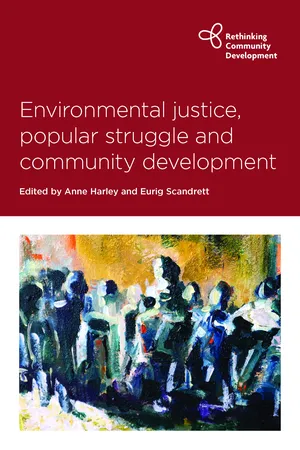
- 228 pages
- English
- ePUB (mobile friendly)
- Available on iOS & Android
About This Book
Struggles for environmental justice involve communities mobilising against powerful forces which advocate 'development', driven increasingly by neoliberal imperatives. In doing so, communities face questions about their alliances with other groups, working with outsiders and issues of class, race, ethnicity, gender, worker/community and settler/indigenous relationships. Written by a wide range of international scholars and activists, contributors explore these dynamics and the opportunities for agency and solidarity. They critique the practice of community development professionals, academics, trade union organisers, social movements and activists and inform those engaged in the pursuit of justice as community, development and environment interact.
Frequently asked questions
Information
Table of contents
- Cover
- Title Page
- Copyright
- Dedication
- Contents
- List of Figures
- Series Editors’ Preface
- Preface
- Acknowledgements
- Notes on Contributors
- Abbreviations
- One: Community, Development and Popular Struggles for Environmental Justice
- Two: Resisting Shell in Ireland: Making and Remaking Alliances Between Communities, Movements and Activists
- Three: ‘No Tenemos Armas Pero Tenemos Dignidad’: Learning From the Civic Strike in Buenaventura, Colombia
- Four: No Pollution and No Roma in My Backyard: Class and Race in Framing Local Activism in Laborov, Eastern Slovakia
- Five: Tackling Waste in Scotland: Incineration, Business and Politics vs Community Activism
- Six: An Unfractured Line: An Academic Tale of Self-Reflective Social Movement Learning in the Nova Scotia Anti-Fracking Movement
- Seven: ‘Mines Come to Bring Poverty’: Extractive Industry in the Life of the People in KwaZulu-Natal, South Africa
- Eight: Ecological Justice for Palestine
- Nine: Learning and Teaching: Reflections on an Environmental Justice School for Activists in South Africa
- Ten: The Environment as a Site of Struggle Against Settler-Colonisation in Palestine
- Eleven: Communities Resisting Environmental Injustice in India: Philanthrocapitalism and Incorporation of People’s Movements
- Twelve: Grassroots Struggles to Protect Occupational and Environmental Health
- Conclusion